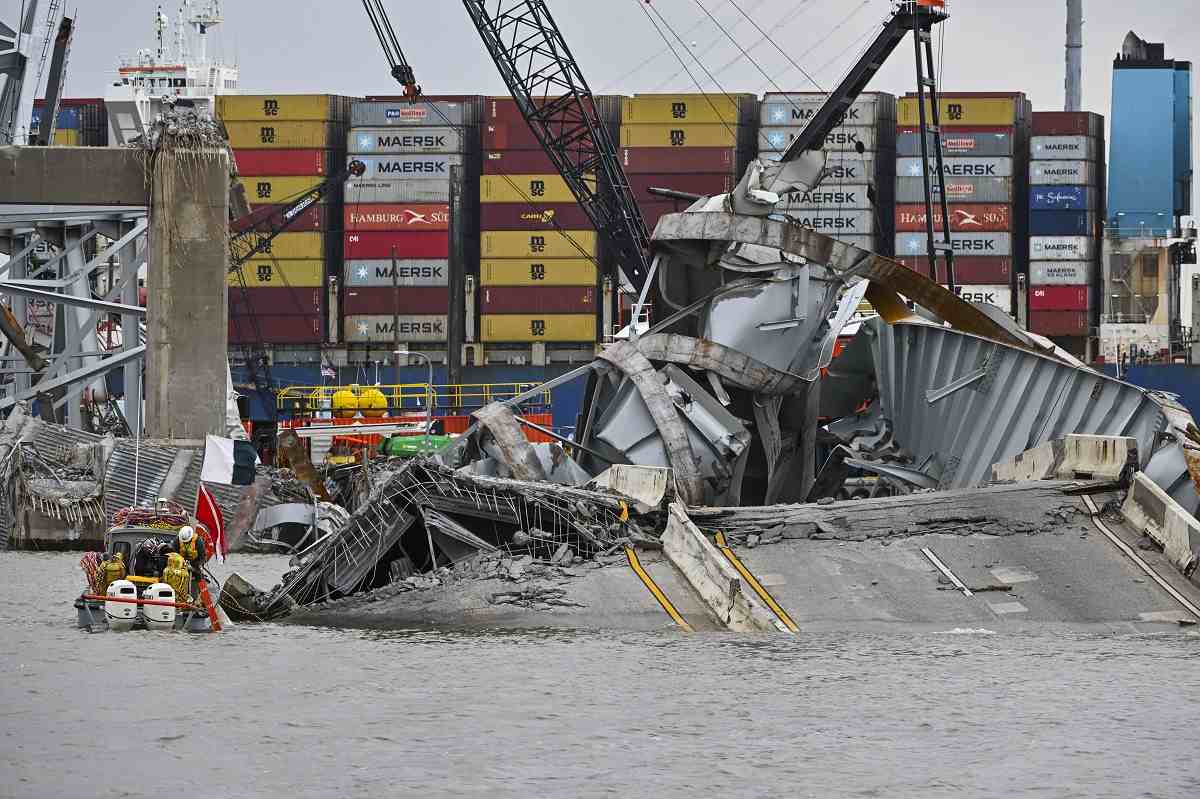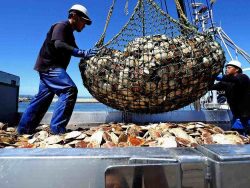‘We’re a Dead Ship’: Hundreds of Cargo Ships Lost Propulsion in U.S. Waters in Recent Years

A diver prepares to enter the water on April 4 at the site of the Key Bridge collapse in Baltimore.
16:34 JST, April 18, 2024
Less than two weeks after Baltimore’s Francis Scott Key Bridge was destroyed by an out-of-control cargo ship, another huge container ship passed beneath a busy bridge connecting New York and New Jersey and then suddenly decelerated in a narrow artery of one of the nation’s largest ports.
“We’re a dead ship,” said a voice over the maritime radio a short time later, invoking an industry term that often refers to a ship that is unable to move on it own.
Three tug boats helped shepherd the APL Qingdao – a vessel more than 1,100 feet long and flying under the flag of Malta – from where it lost propulsion near the Bayonne Bridge to a safe location, authorities said. The ship dropped anchor just upstream from the even busier Verrazzano-Narrows Bridge, which carries about 200,000 vehicles per day.
The April 5 incident is one of hundreds in which massive cargo ships lost propulsion, many near bridges and ports, according to a Washington Post analysis of Coast Guard records.
The findings indicate that the kind of failure that preceded the March 26 Baltimore bridge collapse – the 984-foot Dali is believed to have lost the ability to propel itself forward as it suffered a more widespread power outage – was far from a one-off among the increasingly large cargo ships that routinely sail close to critical infrastructure.
Around Baltimore alone, ships lost propulsion nearly two dozen times in the three years before the tragedy last month, the Post review found – including a November 2021 incident in which a 981-foot container ship lost propulsion for 15 minutes soon after it passed under the Key Bridge. In 2020, a ship the same size as the Dali lost propulsion “in the vicinity of the Bay Bridge” near Annapolis, records show.
Adding to the danger, experts say, is a lack of consistent rules on when cargo ships should be escorted by tug boats that can keep them on course even if engines turn off. While tugboats escorted the Qingdao, as was called for under local guidelines in the New York area, those attending to the Dali departed before it struck the bridge in Baltimore, where such decisions are left to ship captains and local pilots, the specially trained sailors who guide ships in and out of ports.
Container ships like the Dali and the Qingdao have doubled in size over the past two decades, experts said, while some American ports – built up over centuries around busy and cramped waterways – have struggled to adapt.
“I don’t think we’ve understood fully the consequences of these ships, of these large ships, operating in these ports,” said Aaron Davenport, a retired senior Coast Guard officer and expert in maritime safety.
The Post analysis found that 424 cargo ships longer than 600 feet reported losing propulsion – meaning the engines were shut down – in U.S. waters over the past three years. About a quarter of the incidents occurred near a port, bridge or other infrastructure, the analysis found.
The records on propulsion loss were up to date through March 17, before the incidents involving the Dali and the Qingdao. After reports of the Qingdao incident surfaced on social media, the Coast Guard said the ship suffered a loss of propulsion.
In some cases reviewed by The Post, engines suddenly cut out. In others, crews were compelled to shut them down to deal with operating problems. The owner and operator of the APL Qingdao said that its engine was shut down in a “controlled” manner after an engine alarm was triggered and that the ship did not lose electrical power.
In Baltimore, a pilots’ association has said the Dali lost engine and electrical power before it hit the Key Bridge on March 26, and National Transportation Safety Board Chair Jennifer Homendy said investigators believe problems with the electrical system were connected to the loss of control of the ship. The FBI has opened a criminal probe that will look at least in part at whether the crew left the port knowing the vessel had serious systems problems, The Post reported this week.
The Coast Guard reports identified several instances of ships striking objects after losing propulsion, including in one case a grain dock in the Lower Mississippi River. Other vessels were reported to have run aground near infrastructure after losing propulsion.
Coast Guard investigators found many causes for propulsion loss, the records show. In some instances, a total loss of electrical power led to an engine shutdown; in others, the electrical system stayed online, but propulsion was lost because of mechanical and equipment failures. Valves malfunctioned, seals failed, and filters were clogged.
In some cases, poor maintenance or deterioration were blamed for faulty equipment. In others, human error was blamed, including one case in which a ship got underway while an engineer was still doing work on the fuel system. In dozens of instances, investigators reported that tugboats had assisted ships to safety after they lost propulsion.
Ships are at particular risk of losing propulsion when crews are maneuvering in confined waters such as ports, which can place additional demands on power systems, according to a 2017 report by the London P&I Club, a leading maritime insurance firm. Crews changing the type of fuel being used while the ship is underway to comply with regional environmental regulations has also increased the number of propulsion-loss incidents, the report said.
Joseph Ahlstrom, a professor at the State University of New York’s Maritime College, said in an interview that the frequency of propulsion loss points to a risk that must be better managed. Ahlstrom said he hopes the use of tugboats – which routinely help ships dock and undock but can also guide vessels that have lost propulsion to safety – would become more widespread after the Baltimore disaster.
“Most regulations are written in blood,” Ahlstrom said. “It takes something like this for people to say, ‘Whoa, we should do something.’”
‘Our ships are vulnerable’
Ships traveling in U.S. waters are required by federal law to report any loss of propulsion to the nearest Coast Guard command. The Post reviewed hundreds of such reports filed to authorities along the coasts, focusing on those involving ships greater than 600 feet.
While some of the 424 incidents occurred farther from shore in rivers and bays, in 103 instances, the ships suffered a loss of propulsion near a port, bridge or other infrastructure, according to the Coast Guard records.
Capt. John Konrad, founder of the shipping news website gCaptain, said The Post’s findings were cause for concern.
“Our ports are vulnerable,” said Konrad, who was first to report on the Qingdao incident in New York. “America has to decide – do we want to invest in vessel traffic service, stronger bridges, better maritime Coast Guard investigators? Or do we want to roll the dice?”
In the case of the Agios Dimitrios, the ship that lost propulsion in 2021 after passing the Key Bridge as it sailed toward port in Baltimore, investigators concluded that an electrical fault made the engine nonresponsive. Two tugs had been with the ship at the time, and a third joined to assist it back under the bridge to an anchorage near Annapolis for repairs.
Global Ship Lease, owner of the Agios Dimitrios, said in a statement to The Post that the crew followed “established operating protocols.”
“In close coordination with local tug operators and the Coast Guard, the vessel was able to undergo prompt repairs and proceed without further incident,” the company said.
In March 2022, an engine problem and strong winds combined to push a 1,200-foot container ship out of a shipping channel near Norfolk, Coast Guard records show. The chief engineer of the Toledo Triumph requested that the ship’s engines be shut down after engine room fire alarms went off.
At first, according to the investigation report, the ship remained under control. But water leaking from an engine cooling system turned to steam and tripped a separate alarm, preventing the crew from restarting the engine. As the huge ship lost speed, it began to drift, and – pushed by winds of almost 40 mph – it eventually ran aground. The ship suffered no significant damage and freed itself as the tide rose.
Shoei Kisen Kaisha, the Japanese company that manages the Toledo Triumph, declined to comment.
No uniform standard for tugboats
There is no single standard for the use of tugs to escort large ships in and out of ports in the United States, experts said. Instead, their use is determined by a patchwork of federal and state laws, formal guidelines, long-standing practices, the judgments of individual pilots and the financial incentives of ship owners.
As container ships have become larger, maritime officials in New York and New Jersey have developed standards for managing the arrival into the port operated jointly by the states, issuing guidelines on tides, visibility and the use of tugs.
For vessels 997 feet and longer, the guidelines say, two tugs should be on hand at the Narrows, the stretch of water between Staten Island and Brooklyn. As many as five tugs can be required for the largest vessels passing through the Kill Van Kull, the tidal strait between Staten Island and Bayonne, N.J.
Federal laws passed since the 1989 Exxon Valdez oil spill require tug escorts for oil tankers heading into Prince William Sound in Alaska and Puget Sound in Washington state, with a similar state law governing ports in California.
The Maryland Port Administration, which oversees the Baltimore port, and the Virginia Port Authority both said the use of tugs is a decision left to ship captains and to pilots.
Joseph D. Harris, a spokesman for the Virginia agency, said the weather, the size of a vessel and the volume of traffic are all factors pilots take into account in making their decisions.
Jennifer Carpenter, the chief executive of American Waterways Operators, a trade group for tug companies, said that given the diversity of ports in the country, different practices make sense. “It is important to take a port-specific look at what are we trying to do here? What kind of traffic do we have here? How fast are they going? How well are our bridges protected?” Carpenter said. “Those are all things that should go into an analysis.”
Tug escort services cost thousands of dollars an hour, according to rate sheets published by major operators. Experts say some that ship owners are reluctant to use them as they look to keep costs down, and that some port authorities oppose tugboat mandates for fear that charging extra fees will make them lose business to competitors.
“A ship owner and his money are very hard to part, and unless you require it, they’re not going to do it,” said Walter Nadolny, a professor emeritus at SUNY Maritime College. “They’re not crazy about spending the money.”
A ‘dead ship’ in the Kill Van Kull strait
The Qingdao arrived in New York on April 2 and, during a three-day stop, unloaded about 40,000 tons of imports, largely from India and Pakistan, ranging from steel pipes to jasmine rice, according to cargo records.
At 7:29 p.m. on April 5, it set off from Staten Island’s Howland Hook Marine Terminal, bound for Norfolk. The ship was escorted by three tugboats.
The Qingdao passed under the Bayonne Bridge, connecting New Jersey and Staten Island, at 8 p.m., according to records from the shipping data service Kpler. About nine minutes later, as it moved eastward through the tight Kill Van Kull strait, the ship slowed, eventually to 0.5 knots or about 0.6 miles per hour.
At 8:17 p.m., tugboats began an operation to assist the Qingdao, Kpler records show.
At 8:20 p.m., a voice on a marine radio channel covering the area said that the Qingdao was experiencing difficulties. “He has lost propulsion,” the unidentified voice said. “Looks like he might be a dead ship there.” The Post found recordings of the remarks by reviewing marine radio traffic archived by Broadcastify.
Federal regulations define a “dead ship” as one that has lost electrical power and for which backup systems “for bringing the main propulsion into operation” are not available. Other authorities and maritime groups use the term for a vessel that has lost propulsion and steering.
At 8:24 p.m., a different voice came over the radio to say the Qingdao “has lost engine power temporarily, has lost engine power but has regained it back.” This person said the ship was headed for the Stapleton anchorage site near the Verrazzano-Narrows Bridge, which links Staten Island and Brooklyn.
About 35 minutes later, a third voice on the radio said “dead ship, just give me a little bit of time here,” as an alarm seemed to blare in the background, and then a moment later says “so we’re a dead ship.”
The U.S. Coast Guard said in a statement that the Qingdao reported at about 8:30 p.m. that it had lost propulsion in the Kill Van Kull. “The vessel regained propulsion and was assisted to safely anchor in Stapleton Anchorage … by three towing vessels,” the statement said.
Jennifer Petrisko, a spokesperson for CMA CGM, the French shipping giant that owns the Qingdao, said in emails to The Post that the incident began when the ship’s main engine alarm sounded soon after it departed New York, “restricting full maneuvering.” She did not respond when asked why the alarm activated.
The loss of propulsion was “a controlled, agreed upon shutdown of the main engine with approval of the pilot and vessel command to temporarily fix an alarm,” Petrisko said. She added that after inspections and tests, the ship was declared seaworthy and was cleared by the Coast Guard to travel to Virginia. Records show that it departed Stapleton around 6 a.m. on April 6.
Records show that the Qingdao also experienced an engine problem that led to a loss of maneuverability as it left Savannah, Ga., on July 30. The Coast Guard found that the crew had replaced fuel injectors with parts not recommended by the engine’s manufacturer and had failed to keep fuel at a proper temperature, according to a summary of the investigation.
Petrisko did not respond to questions about that incident.
"News Services" POPULAR ARTICLE
-

American Playwright Jeremy O. Harris Arrested in Japan on Alleged Drug Smuggling
-

Taiwan President Shows Support for Japan in China Dispute with Sushi Lunch
-

Japan’s Nikkei Stock Average as JGB Yields, Yen Rise on Rate-Hike Bets
-

Japan’s Nikkei Stock Average Licks Wounds after Selloff Sparked by BOJ Hike Bets (UPDATE 1)
-

Japanese Bond Yields Zoom, Stocks Slide as Rate Hike Looms
JN ACCESS RANKING
-

Japan’s Hopes for Seafood Exports Shot Down in China Spat
-

Keidanren Chairman Yoshinobu Tsutsui Visits Kashiwazaki-Kariwa Nuclear Power Plant; Inspects New Emergency Safety System
-

Japan to Charge Foreigners More for Residence Permits, Looking to Align with Western Countries
-

Japan Exports Rise in October as Slump in U.S. Sales Eases
-

Govt Aims to Expand NISA Program Lineup, Abolish Age Restriction



























